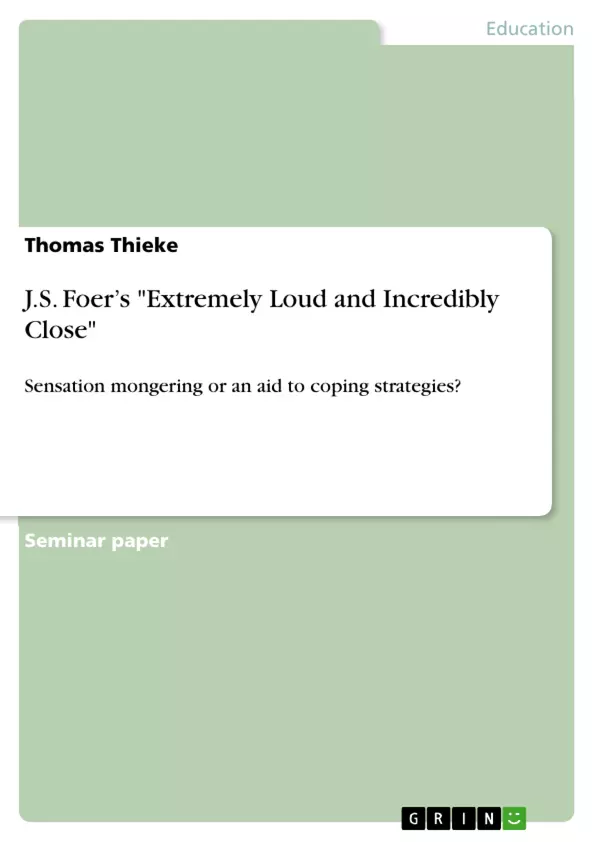The enormous adverse psychological side effects resulting from the 9/11 at-tacks are represented by 13% of lower Manhattan residents even seven years afterwards. Foer has a walk-over attracting a large readership because he utilizes this topic. His rea-dership could have been even bigger if they would have known about the practical im-plementation of coping strategies creatively hidden in the subtext.
It is the main goal of this text to reveal major PTSD (post traumatic stress disorder) symptoms in the main characters in a partly scientific/literary analysis and thus give an idea how the 40% of New York City’s affected school children might have felt in the aftermath of September 11. Relevant coping strategies that ensure a general health-related quality of life can be experienced in a beautiful story about a boy that exceeds his emotional boundaries with the help of his closer and farther related social environment.
Inhaltsverzeichnis (Table of Contents)
- Introduction
- Summary of the Plot
- PTSD and Relevant Coping Strategies
- How is the Story Presented to the Reader and What Does it Create Inside Us?
- Visual Means and Their Stylistical Function
- Structure and Narrators
- Metaphors That Reinforce the Theme of Trauma
- The Concept of "Black"
- Selected Character Analysis Related to Mental Stability
- Oskar
- Grandfather and Grandmother
- Mr. A. R. Black
Zielsetzung und Themenschwerpunkte (Objectives and Key Themes)
The main objective of this text is to analyze Jonathan Safran Foer's Extremely Loud and Incredibly Close, exploring how it portrays the psychological impact of 9/11 on its characters, particularly focusing on PTSD symptoms. The analysis combines literary and scientific perspectives to understand the novel's depiction of coping strategies in the face of trauma.
- The psychological impact of large-scale disasters (specifically 9/11) on individuals and families.
- The portrayal and exploration of PTSD symptoms in children and adults.
- The effectiveness and various forms of coping mechanisms in the aftermath of trauma.
- The use of literary devices (metaphors, symbolism, narrative structure) to convey emotional experiences.
- The novel's potential as a tool for understanding and addressing trauma.
Zusammenfassung der Kapitel (Chapter Summaries)
Introduction: This chapter introduces the devastating psychological effects of 9/11, highlighting the underrepresentation of individual trauma in mainstream media coverage. It establishes the text's goal: to analyze PTSD symptoms in the novel's characters and explore the potential of Foer's work as a resource for understanding coping strategies. The author points to alarming statistics regarding PTSD prevalence among lower Manhattan residents post-9/11, emphasizing the inadequacy of available psychological resources. This sets the stage for exploring the novel as a possible alternative source of support and understanding.
Summary of the Plot: This section provides a concise overview of the novel's plot, focusing on Oskar Schell, a nine-year-old boy grappling with the death of his father in the 9/11 attacks. The summary highlights Oskar's intellectual precociousness, his relationship with his father, and his quest to understand and cope with his father's death. The inclusion of Oskar's actions, such as giving his house key to strangers and playing the tambourine, suggests his unconventional coping mechanisms. The comparison to Oskar Matzerath in Günter Grass's The Tin Drum hints at the thematic parallels of child perspectives on adult trauma.
Schlüsselwörter (Keywords)
PTSD, anxiety disorders, coping strategies, 9/11, character analysis, metaphors, symbols, narrative structure, large-scale disasters, trauma, emotional resilience, literary analysis.
Frequently Asked Questions: Extremely Loud and Incredibly Close Analysis
What is the main objective of this analysis of Jonathan Safran Foer's Extremely Loud and Incredibly Close?
The primary goal is to analyze how the novel portrays the psychological impact of 9/11 on its characters, focusing on PTSD symptoms. It combines literary and scientific perspectives to understand the novel's depiction of coping strategies in the face of trauma.
What are the key themes explored in this analysis?
Key themes include the psychological impact of large-scale disasters (specifically 9/11), the portrayal of PTSD in children and adults, the effectiveness of various coping mechanisms, the use of literary devices to convey emotional experiences, and the novel's potential as a tool for understanding and addressing trauma.
What aspects of the novel are covered in the analysis?
The analysis covers a range of aspects, including a summary of the plot, an exploration of PTSD and coping strategies, an examination of the narrative style and visual means used by the author, a detailed look at the use of metaphors, a character analysis focusing on Oskar, his grandparents, and Mr. Black, and an in-depth discussion of the novel's structure and use of narrators. Specific attention is paid to the symbolic use of "black" within the narrative.
What is included in the "Chapter Summaries" section?
The chapter summaries provide detailed overviews of the introduction (which sets the context and explains the aim of the analysis), and the plot summary, which focuses on Oskar Schell's journey and his attempts to cope with his father's death. Further summaries of other chapters are not provided in this preview.
What are the keywords associated with this analysis?
Keywords include PTSD, anxiety disorders, coping strategies, 9/11, character analysis, metaphors, symbols, narrative structure, large-scale disasters, trauma, emotional resilience, and literary analysis.
What is the target audience for this analysis?
While the provided preview doesn't explicitly state a target audience, the academic nature of the analysis, its focus on PTSD and trauma, and its utilization of literary analysis techniques strongly suggest it is intended for academics, students, and researchers interested in trauma literature and the psychological effects of large-scale disasters.
Where can I find more information about the complete analysis?
The provided text is a preview, offering only a summary of the complete analysis. The location of the full text is not specified.
- Quote paper
- Thomas Thieke (Author), 2010, J.S. Foer’s "Extremely Loud and Incredibly Close", Munich, GRIN Verlag, https://www.hausarbeiten.de/document/153531


